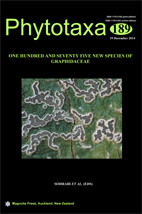Abstract
During a field trip to Grande Terre in New Caledonia in 2012, a number of Graphidaceae were collected, among which 23 species that turned out to represent previously undescribed species: Astrochapsa verruculosa Papong, Lücking & Parnmen, differing from A. megaphlyctidioides in the thinner, verrucose thallus and smaller, distinctly chroodiscoid ascomata; Diorygma roseopruinatum Papong, Lücking & Parnmen, similar to D. junghuhnii but with pink-red pruina covering the ascomata along the slit; Fissurina aurantiacolirellata Papong, Lücking & Kraichak, differing from other species of Fissurina in the prominent to sessile ascomata with bright orange pigment; F. fuscoalba Papong, Lücking & Kraichak, superficially resembling F. pseudostromatica but distinguished by the brown, endoperidermal thallus and the distoseptate ascospores; F. stegoboloides Papong, Lücking & Kraichak, with large ascomata with exposed disc resembling a species of Stegobolus; Graphis leptotremoides Papong, Lücking & Kraichak, differing from other species of Graphis in the gall-forming thallus, in combination with immersed, uncarbonized ascomata; G. subelongata Papong, Lücking & Kraichak, related to G. neoelongata but with less branched lirellae with lateral thalline margin and with narrower, submuriform ascospores; Leucodecton pseudostromaticum Papong, Lücking & Lumbsch, differing from L. expallescens in the pseudostromatic ascomata and larger ascospores becoming brown; Ocellularia albocolumellata Lücking, Lumbsch & Parnmen, similar to O. ripleyi but with uncarbonized excipulum and columella and broader pore of the ascomata; O. albothallina Lücking, Lumbsch & Parnmen, differing from O. pluripora in the loosely corticate, whitish thallus and ascomata with broader pore and broad columella; O. austropacifica Lücking, Lumbsch & Parnmen, resembling O. dolichotata but with green, densely corticate thallus and smaller ascospores; O. fuscosporella Lücking, Lumbsch & Parnmen; differing from O. vizcayensis in the brown ascospores; O. inconspicua Lücking, Lumbsch & Parnmen, akin towards O. pseudopyrenuloides but with ascomata with narrower pore and uncarbonized columella and with broader ascospores; O. neocaledonica Lücking, Lumbsch & Parnmen, differing from O. pluripora in the ligher thallus and lack of secondary substances; O. pulchella Lücking, Lumbsch & Parnmen, resembling Ocellularia mammicula but with green, minutely grainy thallus with columnar clusters of calcium oxalate crystals and with ascomata with narrower, non-annulate pore; O. rugosothallina Lücking, Lumbsch & Parnmen, differing from O. perforata in the carbonized excipulum and columella; O. salmonea Lücking, Lumbsch & Parnmen, similar to O. baileyi in the salmon-pink medulla but with larger ascomata with only partially carbonized excipulum and with larger ascospores; Pseudotopeliopsis longispora Papong, Lücking & Parnmen, differing from other species of Pseudotopeliopsis in the long, transversely septate ascospores; Rhabdodiscus farinosus Papong, Lücking & Parnmen, differing from other species of Rhabdodiscus in the ecorticate, finely farinose and sorediate thallus; R. neocaledonicus Lücking, Lumbsch & Parnmen, similar to R. lankaensis in the salmon-pink ascoma pigment but with submuriform, brown ascospores; R. saxicola Lücking, Lumbsch & Parnmen, growing saxicolous and with pseudostromatic ascomata with broad brown rim and columella contrasting with the light yellowish brown thallus; R. thouvenotii Lücking, Lumbsch & Parnmen, similar to R. saxicola but with larger, more or less solitary ascomata with narrower pore and finger-like columella; and Thelotrema perriei Papong, Lücking & Lumbsch, differing from T. diplotrema in the densely corticate, verrucose thallus and smaller ascospores. The number of new discoveries demonstrates that the South Pacific is a center of diversity of Graphidaceae. We also propose the new combinations Ocellularia mammicula (Hale) Lücking, O. permaculata (Nagarkar & Hale) Lücking and Rhabdodiscus lankaensis (Hale) Lücking.

